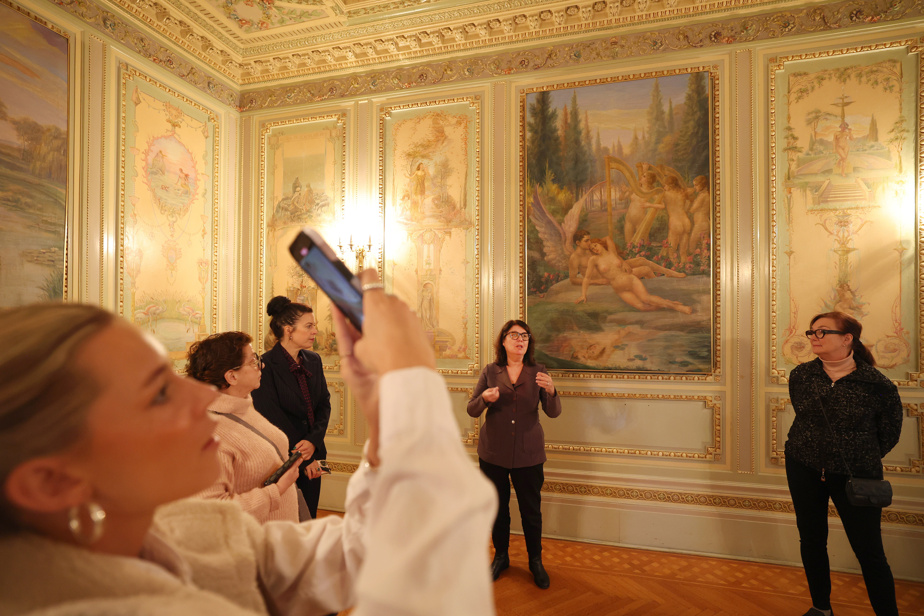“Château Dufresne is the only significant secular work by Guido Nincheri that still exists in Canada,” underlines general director and curator Manon Lapointe.
There are several of us who have often passed by Château Dufresne without ever having visited it. Behind its imposing facade, the walls bear the artistic legacy of Guido Nincheri, nicknamed the Michelangelo of Quebec.
His work can be admired at the Saint-Léon de Westmount and Saint-Esprit de Rosemont churches, while people are restoring his frescoes at the Sainte-Madeleine church in Outremont1. But he didn’t just make religious art. The exhibition From Profane to Sacred, on display until June 30, allows you to discover his rich contribution to Château Dufresne.
It is not for nothing that brothers Marius and Oscar Dufresne called on the services of the Italian-born painter to decorate the walls of their two semi-detached houses located at the corner of Rue Sherbrooke Est and Boulevard Pie-IX.
Sons of a couple who had made their fortune in the field of shoes (thanks to the know-how of their mother Victoire Du Sault, as told in the film La Cordonnière and in the books by Pauline Gill), the Dufresne brothers were great visionaries and historical builders of eastern Montreal. Engineer, Marius Dufresne drew the plans for the park and the Maisonneuve market. He was inspired by the Champs-Élysées to create boulevards Morgan and Pie-IX. More focused on business and politics within the ancient city of Maisonneuve, his brother Oscar donated the land of the Botanical Garden to Marie-Victorin.
The two brothers founded the Dufresne Construction Company and the Dufresne Engineering Company, then they had Château Dufresne built between 1915 and 1918. “They wanted to create a counterweight to the English-speaking bourgeoisie of the Golden Square Mile on Sherbrooke West,” says Manon Lapointe. .
The offices of their two companies occupied an Art Deco building at 1832 Pie-IX Boulevard. In exchange for decorating Château Dufresne, the Dufresne brothers offered Guido Nincheri space at the back so that the master glassmaker could set up his workshop. The premises are also being renovated with the aim of creating an interpretation center open to the public.
“The Dufresnes are responsible for the construction of bridges and dams,” adds Manon Lapointe. Marius also died when he was hit by a beam on the construction site of the bridge which connects Laval and Rosemère and which today bears his name.
“It was by mutual agreement with Nincheri,” explains Ms. Lapointe. It was a compromise to use water-based paint so that it was reversible. »
Nincheri wanted his nude paintings to be rediscovered, but it was not that simple. In 1957, Château Dufresne was purchased by the City of Montreal. After “a dark period of abandonment and vandalism,” says Ms. Lapointe, there was talk of demolishing it with a view to making it a parking lot for the Olympic Games, but the Macdonald Stewart Foundation saved the furniture and the Château was been declared a historic monument. It was restored in 1975 by the artist Nicolas Sollogoub, and it was there that works by Nincheri were able to see the light of day again.
Another fascinating fact: Nincheri spent the end of his life in New England, after years of incarceration. He was in fact accused of fascism for having painted Mussolini on horseback at the Notre-Dame-de-la-Defense church, in Little Italy. “You have to know, and this is what his wife Giulia demonstrated, that he was responding to a firm request,” underlines Manon Lapointe. And that was before Mussolini became the dictator we know.
The exhibition From Profane to Sacred offers a new tour of Château Dufresne to discover his invaluable contribution, as well as a temporary section with sketches, original works and a video on his workshop which had around ten employees.
Château Dufresne represents an important part of the history of Montreal. It will celebrate its 50th anniversary as a historic monument in 2026, at the same time as that of the Montreal Olympic Games.
